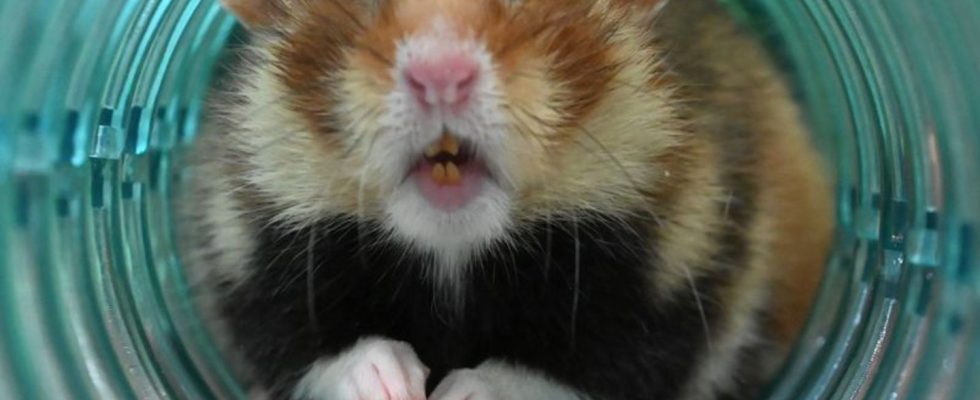Battle for the last field hamsters – time is pressing
Field hamsters used to be fought for a long time. Today the populations are getting smaller. photo
© Axel Seidemann/dpa
Save the last wild hamsters from extinction. The cross-state project “Feldhamsterland” wants to contribute to this ambitious goal. But the funding has expired – what’s next?
The hole in the tunnel dug diagonally into the earth in a barley field in Mainz leads to the construction of a field hamsters. The animal cannot be seen.
“Hamsters are usually active at dusk and at night, and mostly only inexperienced, young animals dare to go outside during the day,” says Janina Langner from the “Feldhamsterland” project, which is supported by the Nature and Environment Foundation in Rhineland-Palatinate. A total of five federal states (Hesse, Lower Saxony, Rhineland-Palatinate, Saxony-Anhalt and Thuringia) are participating in the joint project funded by the Federal Agency for Nature Conservation.
After five years, however, the funding is now running out and is being handed over to the federal states. With different starting points, as the conservation geneticist Tobias Erik Reiners from the Senckenberg Research Institute, who is involved in the project, says. But one problem is the same in all federal states: the time factor. “Processes to protect hamsters are all taking far too long – and extinctions continue.” Langner also says: “The populations are getting smaller and smaller.”
Farmers should help protect
In the “Feldhamsterland” project, the remaining stocks of the rodents, which are around 25 centimeters long, were recorded and protective measures tested. Cooperation between agriculture and nature conservation is the best way, emphasizes Reiners. According to Langner, things are going very well in Rhineland-Palatinate, for example. “As children, many farmers hunted hamsters for fur production, today they see that there are hardly any hamsters left and want to help with their work to save the species from extinction.” The farmers receive compensation for the protective measures.
Flower strips, cultivation of lucerne, renunciation of harvest, later mowing of grain or the so-called ear harvest with the mower raised so that the stalks remain: Farmers can give hamsters more food and cover from enemies such as birds of prey, foxes and cats. “If the cover is gone after a harvest, up to 90 percent of the hamsters die,” explains Reiners. He speaks of a real “race against harvest time”. Every day more gives young hamsters some breathing space while growing up.
In addition, the time of hoarding coincides with the usual harvest time, adds Langner. Again, each day brings more of a survival benefit. A field hamster needs at least two kilograms of grains and seeds to get through the winter.
Once upon a time there were many European hamsters (Cricetus cricetus) in Germany. “In the post-war period, they were even a real nuisance and were hunted down because people wanted to protect their harvest,” says Langner. In the course of the industrialization of agriculture, the stocks dwindled rapidly, as in many other countries in the distribution area, according to analyzes probably partly due to the one-sided nutrition in the monocultures and the earlier harvest times.
Field hamsters have been fought for a long time
In Thuringia, the animals were still being fought into the 1980s, says Senckenberg researcher Reiners. As in Saxony-Anhalt, there were once a particularly large number of hamsters there – but in both federal states their numbers had fallen particularly sharply. And it is precisely there that there are still serious conflicts between agriculture and nature conservation.
Reiners cites Hesse as a positive example, where there is a state office for field hamster protection and where stocks are developing well, at least in some areas. Rhineland-Palatinate is also a role model – “however, the commitment probably comes five to six years too late”. In Worms, for example, the stock could be gone this year.
Overall, according to Langner, there is probably still a population in the “low three-digit range” in the state. During mapping forays in the spring, around 200 burrows of the solitary animals were found, 184 of them in the Ebersheim district of Mainz, the “hotspot area” of the state.
Targeted propagation of animals
In addition to protective measures, the targeted reproduction of animals, which are then returned to the wild, is one way to help the endangered species. “Initiatives for breeding and reintroduction are many times more expensive,” explains researcher Reiners. “But it won’t work without her.” In the Mainz area and in other isolated occurrences, the low number of animals leads to inbreeding and the loss of genetic diversity.
In Hesse, there is a new conservation breed for the Society for Ornithology and Nature Conservation, and the hamsters have been bred in the Opel Zoo for a long time. The first conservation breed in Germany was created in 2004 at the Heidelberg Zoo, says the project manager there, Ulrich Weinhold. About 200 animals are resettled in the wild from here every year. This is a long-term project. And here too, according to Weinhold, is the problem: time is of the essence.

